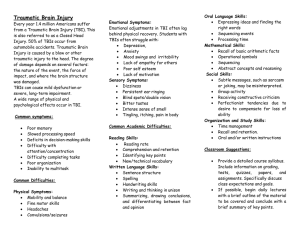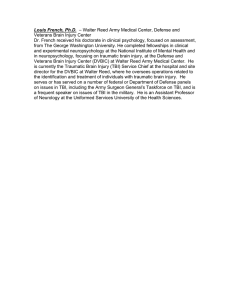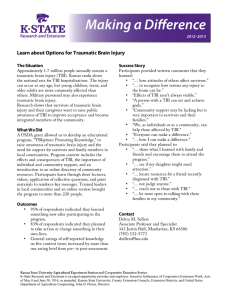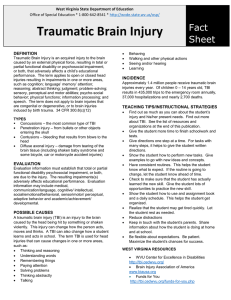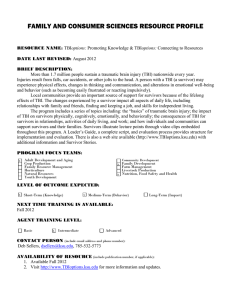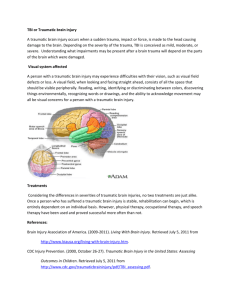Social Communication and Traumatic Brain Injury
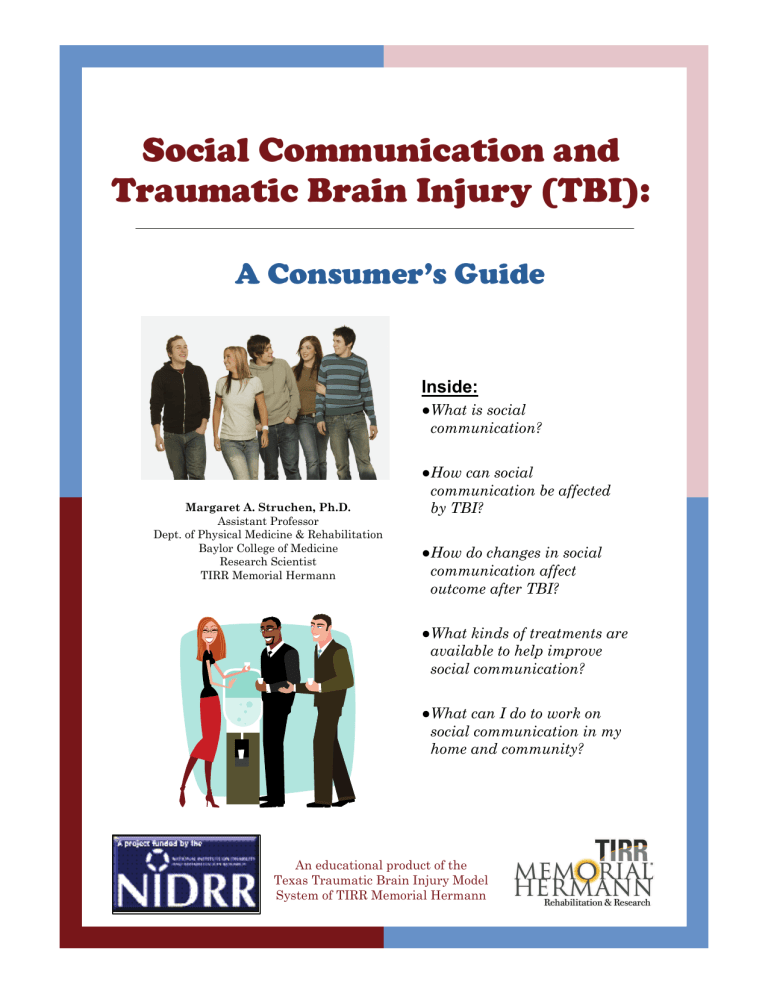
Social Communication and
Traumatic Brain Injury (TBI):
A Consumer’s Guide
Margaret A. Struchen, Ph.D.
Assistant Professor
Dept. of Physical Medicine & Rehabilitation
Baylor College of Medicine
Research Scientist
TIRR Memorial Hermann
Inside:
● What is social communication?
● How can social communication be affected by TBI?
● How do changes in social communication affect outcome after TBI?
● What kinds of treatments are available to help improve social communication?
● What can I do to work on social communication in my home and community?
An educational product of the
Texas Traumatic Brain Injury Model
System of TIRR Memorial Hermann
Social Communication and TBI
What is social communication?
Social communication involves sending and receiving messages to and from others.
Social communication involves being able to understand others and the meaning of what they communicate to you. It also involves being able to express yourself with the meaning you intend to communicate to them.
Social communication includes many skills.
These skills can be verbal (the words that you say) or nonverbal (how the words are said). In fact, how something is said can be more important than what is said.
Some examples of social communication skills include:
Starting conversations
Staying on topic
Changing conversation topic
Choosing topics of conversation
Asking for clarification
Voice tone
Gestures
Facial expressions
Rate of speech and many more…..
Social communication can change depending on the situation.
In addition to verbal and nonverbal skills, the specific context in which the communication is taking place must be considered. That is, a person needs to adjust how they communicate depending on the situation in which they are involved and the persons with whom they are talking. For example, the communication style you use when talking with an employer during a job interview will likely be very different than that used when talking with friends at a party.
Page 2
Social Communication after Traumatic Brain Injury (TBI):
A Consumer’s Guide
How can social communication be affected by TBI?
Social communication changes following TBI can be the direct result of the traumatic brain injury itself. Bruising, bleeding, and stretching and tearing of nerve cells within the brain as a result of injury can lead to cognitive (thinking) problems. Some of the most common cognitive problems include slowed processing (taking a longer time to process information), difficulty with attention and memory functioning, and executive dysfunction (problems with goal-setting, planning, sequencing, etc.). These cognitive problems can contribute to social communication difficulties. For example:
Attention/Concentration problems can lead to:
Difficulty staying on topic
Problems keeping track of the conversation
Problems in changing topics or shifting between speaker and listener roles
Memory problems can lead to :
Repeating self when talking
Losing track of conversation topic
Mixing up instructions or messages
Executive Functioning problems can lead to :
Difficulty understanding sarcasm or
“getting the joke”
Having trouble starting conversations
Poor use of feedback from others
Interrupting others
Poorly organized speech
Excessive talking
Difficulty taking someone else’s perspective
Page 3
Social Communication and TBI
How do changes in social communication affect outcome after TBI?
Changes in social communication can be one of the most difficult problems for persons with traumatic brain injury
(TBI).
Changes in social communication can be relatively mild, such as having problems with word-finding in conversation. Or, changes can be more widespread, affecting several aspects of communication.
Social communication skills play a key role in being successful in one’s home life, work, and school following
TBI. Communication difficulties can affect the ability to get and maintain a job after injury. It can also affect the ability to make and keep friendships and can impact family relationships.
“After my injury, a lot of my old friends didn’t seem to want to come around. I think they felt uncomfortable because I talked and acted differently than I had before.
Loneliness was a big problem.”
Although therapies to help improve social communication abilities are commonly offered in rehabilitation programs, there have been very few studies to look at how well these treatments work.
Of the studies that have been done, the results have been generally supportive. That is, the treatments have seemed to be helpful in improving social communication skills.
Few studies have looked at how well a person does after treatment has been ended for a period of time or how well the skills learned in therapy have been adopted in the person with injury’s daily life.
It has become more and more important to show that rehabilitation treatments produce helpful results for clients.
More research is being done to try to help learn about how to best help improve social communication.
Page 4
Social Communication after Traumatic Brain Injury (TBI):
A Consumer’s Guide
What kinds of treatments are available to help improve social communication?
Many rehabilitation programs offer services to help people with brain injury to improve their social communication abilities. Sometimes these services are offered on an individual basis
(like individual speech therapy) and sometimes group treatment is offered. The main ways in which therapists will try to help is by using the following techniques:
Structured Feedback : getting information from someone who is trusted about what aspects of communication went well and what aspects need to be worked on can be useful. This is especially helpful if the feedback can be given immediately after the conversation takes place.
Use of Videotaped Interactions: videotaping conversations and then playing them back can be very helpful in increasing awareness of communication strengths and weaknesses.
Modeling: a therapist or other communication partner may demonstrate ways to handle different communication situations.
Role-play and rehearsal: practicing different communication situations in can be very helpful.
Positive Reinforcement: providing praise and encouragement for positive communication behaviors can help.
Homework: working on communication skills in daily life is especially important. The more opportunities that a person can work on communication behaviors outside of therapy, the more likely that positive changes will be made.
A key factor in improving social communication skill is often the involvement of family members, friends, and others in the community in helping to develop and practice skills and to provide feedback and support. A trusted family member or friend can help provide feedback, can provide coaching and encouragement, and can help practice communication skills.
“My best friend was a real help to me. She took the time to help coach me to help me become more aware when I was going on and on in conversation. We came up with a signal that she could use with me so that I would get better at taking turns in talking.”
Page 5
Social Communication and TBI
What can I do to work on social communication in my home and community?
Identify a family member or friend that you feel comfortable with, and ask them to help you by providing feedback and support. (If you are a family member or friend, let your loved one with brain injury know that you’re willing to help.)
Take the time you need to answer others or explain your needs. Let others know that it might take longer for you to get your ideas out, but that you have something to say. Allow more time for your loved one to answer you or explain what he or she wants.
It’s okay to use gestures or signals (for example, hand motions and facial expressions) to help express yourself if you are having trouble coming up with the words you want to use.
Work with a family member or friend to develop a signal that will let you know when you have gotten off topic. For example, they might hold up your index finger to let you know you are off topic. If signals don’t work, your family member or friend might help you get back on track by saying, “We were talking about… ”
When providing feedback, remember to use kind words and a gentle tone of voice. This will make it easier for your loved one to accept what you say. Also, take care to provide feedback in a way that does not embarrass your loved one
Page 6
Social Communication after Traumatic Brain Injury (TBI):
A Consumer’s Guide
Ask for others to repeat important information, if needed, so you are sure you’ve understood what has been said.
You can also try paraphrasing (saying it back in your own words) what was said to you to be sure that you understand.
Try to limit distrac ons .
If peer partner gets easily distracted and has di ffi culty staying focused on the conversa on, you can encourage them to try to “manage” the situa on by limi ng sources of distrac on. That is, they may need to turn o ff the television or move to a quieter room when having a conversa on with others.
Pay a en on to the body language of the person with whom you are talking.
The other person’s body language and expressions can give feedback about their interest in the conversa on. For example, if the person is yawning, looking at their watch, or looking away, this should be a sign that they might be feeling bored. You can use these cues to make changes in your communica on. If the other person is looking bored, for example, this is a sign to stop talking and let the other person have
a chance to talk.
Work with a family member or friend to coach you, if you have been told that you sometimes talk about something too personal or offensive to others. You might develop a signal to help let them know that this is occurring. You might have them hold up their hand or some other signal that you have agreed upon. Later, discuss the situation with your family member or friend and discuss what made them uncomfortable and how this could affect friendships with others. You can also try to remember to stick to “safe” topics, like talking about sports, the news, or the weather, especially when talking with someone you don’t know well.
Remember that feedback should include information about positive aspects of social communication, not just about problem areas.
We all need to have encouragement and recognition of our strengths in addition to areas that need work!
“When I’m out with my brother, I always try to let him know when I think he’s doing a great job in paying attention to the conversation and when he starts a conversation with someone new. These used to be big problem areas for him. He has worked really hard to improve and I want him to see that others notice the changes.”
Page 7
S o c i a l C o m m u n i c a t i o n a f t e r Tr a u m a t i c B r a i n I n j u r y ( T B I ) :
A C o n s u m e r ’s G u i d e
Texas Traumatic Brain Injury Model System at TIRR Memorial Hermann
Brain Injury Research Center
2323 Shepherd, Suite 907
Houston, Texas 77019
Phone: 713-630-0522
Fax: 713-630-0529
E-mail: struchen@bcm.edu
This educational brochure was sponsored by a grant from the National Institute on
Disability and Rehabilitation Research, U.S. Department of Education, for the Texas
Traumatic Brain Injury Model System at TIRR Memorial Hermann (Grant #: H133A070043).
